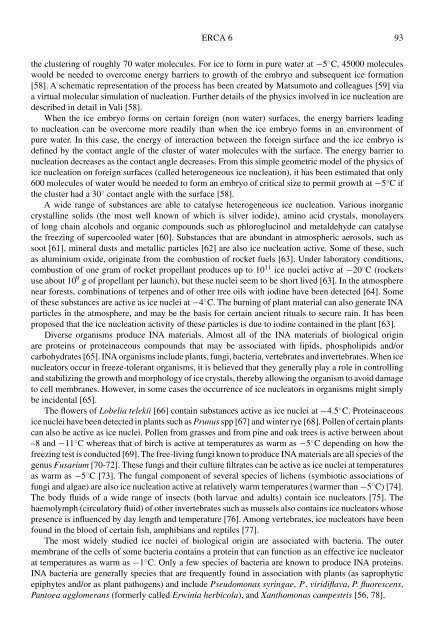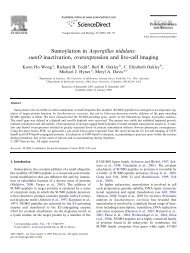Ice nucleation active bacteria and their potential role in precipitation
Ice nucleation active bacteria and their potential role in precipitation
Ice nucleation active bacteria and their potential role in precipitation
You also want an ePaper? Increase the reach of your titles
YUMPU automatically turns print PDFs into web optimized ePapers that Google loves.
ERCA 6 93<br />
the cluster<strong>in</strong>g of roughly 70 water molecules. For ice to form <strong>in</strong> pure water at −5 ◦ C, 45000 molecules<br />
would be needed to overcome energy barriers to growth of the embryo <strong>and</strong> subsequent ice formation<br />
[58]. A schematic representation of the process has been created by Matsumoto <strong>and</strong> colleagues [59] via<br />
a virtual molecular simulation of <strong>nucleation</strong>. Further details of the physics <strong>in</strong>volved <strong>in</strong> ice <strong>nucleation</strong> are<br />
described <strong>in</strong> detail <strong>in</strong> Vali [58].<br />
When the ice embryo forms on certa<strong>in</strong> foreign (non water) surfaces, the energy barriers lead<strong>in</strong>g<br />
to <strong>nucleation</strong> can be overcome more readily than when the ice embryo forms <strong>in</strong> an environment of<br />
pure water. In this case, the energy of <strong>in</strong>teraction between the foreign surface <strong>and</strong> the ice embryo is<br />
def<strong>in</strong>ed by the contact angle of the cluster of water molecules with the surface. The energy barrier to<br />
<strong>nucleation</strong> decreases as the contact angle decreases. From this simple geometric model of the physics of<br />
ice <strong>nucleation</strong> on foreign surfaces (called heterogeneous ice <strong>nucleation</strong>), it has been estimated that only<br />
600 molecules of water would be needed to form an embryo of critical size to permit growth at −5 ◦ Cif<br />
the cluster had a 30 ◦ contact angle with the surface [58].<br />
A wide range of substances are able to catalyse heterogeneous ice <strong>nucleation</strong>. Various <strong>in</strong>organic<br />
crystall<strong>in</strong>e solids (the most well known of which is silver iodide), am<strong>in</strong>o acid crystals, monolayers<br />
of long cha<strong>in</strong> alcohols <strong>and</strong> organic compounds such as phlorogluc<strong>in</strong>ol <strong>and</strong> metaldehyde can catalyse<br />
the freez<strong>in</strong>g of supercooled water [60]. Substances that are abundant <strong>in</strong> atmospheric aerosols, such as<br />
soot [61], m<strong>in</strong>eral dusts <strong>and</strong> metallic particles [62] are also ice <strong>nucleation</strong> <strong>active</strong>. Some of these, such<br />
as alum<strong>in</strong>ium oxide, orig<strong>in</strong>ate from the combustion of rocket fuels [63]. Under laboratory conditions,<br />
combustion of one gram of rocket propellant produces up to 10 11 ice nuclei <strong>active</strong> at −20 ◦ C (rockets<br />
use about 10 9 g of propellant per launch), but these nuclei seem to be short lived [63]. In the atmosphere<br />
near forests, comb<strong>in</strong>ations of terpenes <strong>and</strong> of other tree oils with iod<strong>in</strong>e have been detected [64]. Some<br />
of these substances are <strong>active</strong> as ice nuclei at −4 ◦ C. The burn<strong>in</strong>g of plant material can also generate INA<br />
particles <strong>in</strong> the atmosphere, <strong>and</strong> may be the basis for certa<strong>in</strong> ancient rituals to secure ra<strong>in</strong>. It has been<br />
proposed that the ice <strong>nucleation</strong> activity of these particles is due to iod<strong>in</strong>e conta<strong>in</strong>ed <strong>in</strong> the plant [63].<br />
Diverse organisms produce INA materials. Almost all of the INA materials of biological orig<strong>in</strong><br />
are prote<strong>in</strong>s or prote<strong>in</strong>aceous compounds that may be associated with lipids, phospholipids <strong>and</strong>/or<br />
carbohydrates [65]. INA organisms <strong>in</strong>clude plants, fungi, <strong>bacteria</strong>, vertebrates <strong>and</strong> <strong>in</strong>vertebrates.When ice<br />
nucleators occur <strong>in</strong> freeze-tolerant organisms, it is believed that they generally play a <strong>role</strong> <strong>in</strong> controll<strong>in</strong>g<br />
<strong>and</strong> stabiliz<strong>in</strong>g the growth <strong>and</strong> morphology of ice crystals, thereby allow<strong>in</strong>g the organism to avoid damage<br />
to cell membranes. However, <strong>in</strong> some cases the occurrence of ice nucleators <strong>in</strong> organisms might simply<br />
be <strong>in</strong>cidental [65].<br />
The flowers of Lobelia telekii [66] conta<strong>in</strong> substances <strong>active</strong> as ice nuclei at −4.5 ◦ C. Prote<strong>in</strong>aceous<br />
ice nuclei have been detected <strong>in</strong> plants such as Prunus spp [67] <strong>and</strong> w<strong>in</strong>ter rye [68]. Pollen of certa<strong>in</strong> plants<br />
can also be <strong>active</strong> as ice nuclei. Pollen from grasses <strong>and</strong> from p<strong>in</strong>e <strong>and</strong> oak trees is <strong>active</strong> between about<br />
–8 <strong>and</strong> −11 ◦ C whereas that of birch is <strong>active</strong> at temperatures as warm as −5 ◦ C depend<strong>in</strong>g on how the<br />
freez<strong>in</strong>g test is conducted [69]. The free-liv<strong>in</strong>g fungi known to produce INA materials are all species of the<br />
genus Fusarium [70-72]. These fungi <strong>and</strong> <strong>their</strong> culture filtrates can be <strong>active</strong> as ice nuclei at temperatures<br />
as warm as −5 ◦ C [73]. The fungal component of several species of lichens (symbiotic associations of<br />
fungi <strong>and</strong> algae) are also ice <strong>nucleation</strong> <strong>active</strong> at relatively warm temperatures (warmer than −5 ◦ C) [74].<br />
The body fluids of a wide range of <strong>in</strong>sects (both larvae <strong>and</strong> adults) conta<strong>in</strong> ice nucleators [75]. The<br />
haemolymph (circulatory fluid) of other <strong>in</strong>vertebrates such as mussels also conta<strong>in</strong>s ice nucleators whose<br />
presence is <strong>in</strong>fluenced by day length <strong>and</strong> temperature [76]. Among vertebrates, ice nucleators have been<br />
found <strong>in</strong> the blood of certa<strong>in</strong> fish, amphibians <strong>and</strong> reptiles [77].<br />
The most widely studied ice nuclei of biological orig<strong>in</strong> are associated with <strong>bacteria</strong>. The outer<br />
membrane of the cells of some <strong>bacteria</strong> conta<strong>in</strong>s a prote<strong>in</strong> that can function as an effective ice nucleator<br />
at temperatures as warm as −1 ◦ C. Only a few species of <strong>bacteria</strong> are known to produce INA prote<strong>in</strong>s.<br />
INA <strong>bacteria</strong> are generally species that are frequently found <strong>in</strong> association with plants (as saprophytic<br />
epiphytes <strong>and</strong>/or as plant pathogens) <strong>and</strong> <strong>in</strong>clude Pseudomonas syr<strong>in</strong>gae, P . viridiflava, P. fluorescens,<br />
Pantoea agglomerans (formerly called Erw<strong>in</strong>ia herbicola), <strong>and</strong> Xanthomonas campestris [56, 78].









